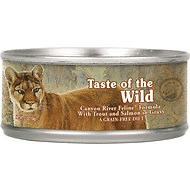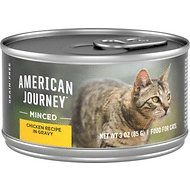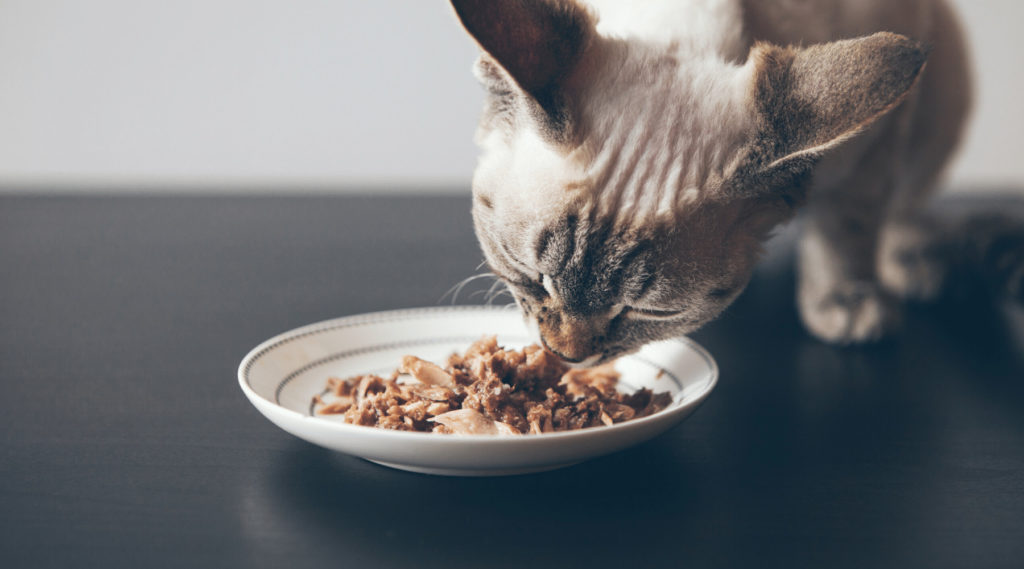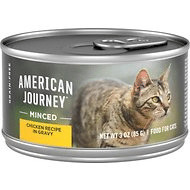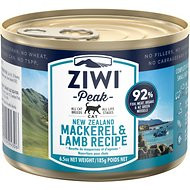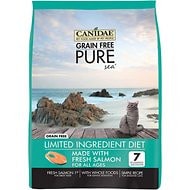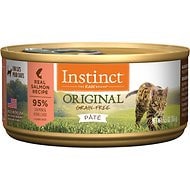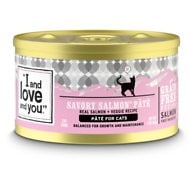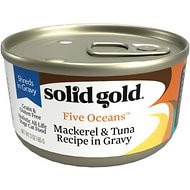Contents
- What Is The Best Cat Food For Dry Flaky Skin and Dandruff?
- Understanding Common Cat Skin Problems
- How to Remedy Dry, Flaky Skin and Dandruff
- What to Look for in a Good Cat Food for Dry Skin
- How Do We Make Our Recommendations?
- The 9 Best Cat Foods for Dry, Flaky Skin and Dandruff
- 5 More Top-Rated Cat Foods for Dry, Flaky Skin and Dandruff
- Canidae Grain-Free PURE Sea Limited Ingredient with Salmon Recipe
- Instinct by Nature’s Variety Original Grain-Free Real Salmon Canned Food
- Halo Holistic Seafood Medley Sensitive Stomach Dry Food
- I and Love and You Savory Salmon Pate Grain-Free Canned Cat Food
- Solid Gold Five Oceans Mackerel & Tuna Recipe in Gravy Canned Food
- Frequently Asked Questions
We all get dry skin from time to time, especially when the weather turns cold. Dry skin is generally nothing to be concerned about and is easily resolved with a good moisturizer or hand lotion. When it comes to your cat, however, you probably don’t think much about his skin, and you may not even realize that cats can develop skin problems. After all, their skin is protected by a thick layer of fur.
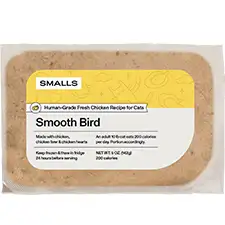
Smalls Human-Grade Ground Bird Fresh Cat Food
- Natural sources of taurine
- High in protein
Your cat’s fur provides some degree of protection for the skin underneath, but cats are by no means exempt from skin issues. Cats can develop dry, flaky skin and dandruff as well as other skin problems. Though the same problems may be minor in humans, noticeable changes to your cat’s skin and coat could indicate an underlying health problem and should not be ignored.
In this article, we’ll cover the subject of common cat skin problems including dry, flaky skin and dandruff. We’ll explore the most common causes of skin and coat issues in cats and talk about the best ways to resolve them. You’ll also learn more about the role diet plays in your cat’s skin and coat health then provide you with some recommendations for the best cat food for dry skin and dandruff.
What Is The Best Cat Food For Dry Flaky Skin and Dandruff?
- Small Ground Bird Human-Grade Fresh Cat Food
- Taste of the Wild Canyon River Grain-Free Canned
- American Journey Salmon & Tuna Recipe in Gravy
- Ziwi Peak Lamb Recipe Canned Food
- Canidae Grain-Free PURE Sea Limited Ingredient
- Instinct by Nature’s Variety Original Grain-Free
- Halo Holistic Seafood Medley Sensitive Stomach
- I and Love and You Savory Salmon Pate Grain-Free
- Solid Gold Five Oceans Mackerel & Tuna Recipe in Gravy
Understanding Common Cat Skin Problems
The easiest way to tell if your cat has dry skin is to run your hand down his back and check for flakes. Flaky skin and dandruff are key indicators of dry skin and dry skin can be linked to a number of skin problems. Other symptoms of skin problems in cats include frequent or severe itching and scratching, crusty or scaly patches of skin, patches of hair loss, inflammation, and poor coat condition. Different symptoms are related to different problems, so it is important to determine the underlying cause of your cat’s skin problems before you try to treat them.
Here are some of the primary common causes of skin problems in cats:
- Parasites like fleas, ticks, or mites
- Ear mites or mange mites
- Ringworm (a common fungal infection)
- Environmental allergies (like dust, mold, or pollen)
- Bacterial skin infection
- Food allergies or sensitivities
Parasites like fleas, ticks, and mites feed on the skin or blood of living animals. In many cases, fleas only cause minor itching and irritation, but some cats develop an allergy to the flea’s saliva which could lead to more severe symptoms. Ear mites are most commonly seen in younger cats and symptoms are typically localized to the ear area. Ringworm is a fungal infection that typically results in ring-like lesions on the skin paired with scaling and thickened skin, but they aren’t usually itchy.
If you find your cat itching and scratching a lot, it could be the result of environmental allergies. Cats can be allergic to many of the same things as humans, including things like dust, pollen, and mold. Because cats groom themselves so much, they can spread the allergen all over their bodies and make the itching worse. Bacterial skin infections are often secondary to another condition and can be the result of intense scratching that damages the skin. Food allergies and sensitivities also tend to manifest with skin-related symptoms such as itching, flaking, and recurrent ear infections.
Now that you have a better understanding of common cat skin problems, let’s take a closer look at the causes and treatments for dry, flaky skin and dandruff.
How to Remedy Dry, Flaky Skin and Dandruff
Dry skin is a fairly common problem in cats. In many cases, the most noticeable symptom is frequent itching and scratching. Some cats respond to the itching by over-grooming themselves which can lead to patches of hair loss. If the itching gets worse, your cat might start scratching too hard or even biting the skin which can break the skin and open him up to a secondary bacterial skin infection.
If you notice that your cat is scratching more than usual, you should take a closer look to check for additional symptoms. Use your fingers to part the hair at behind your cat’s neck, along his spine, and at the base of the tail to check for dandruff or external parasites. If your cat’s scratching seems to be localized to the head and neck it can be an indication of a food allergy. Food allergies are also linked to recurrent ear infections and, if left untreated, can lead to poor coat condition and patches of hair loss. If you notice that your cat’s hair is thinning around the tail area, it might be fleas.
The first thing you should do when you notice your cat’s dry skin is take him to the vet. Your veterinarian will be able to diagnose your cat’s underlying problem and help you determine the best treatment.
Here are some common treatment options and home remedies for dry skin on cats:
- Increase the protein content of your cat’s diet – cats require a high concentration of protein in their diets for optimal health which includes skin and coat health.
- Eliminate the source of your cat’s allergies, either environmental or food allergies, and his symptoms should resolve within a few weeks or months.
- Give your cat an omega-3 fatty acid supplement like fish oil – omega-3s are important for skin health and moisture in cats.
- Bathe your cat with a moisturizing shampoo – it will also help remove some of the flaky skin so new, healthy skin can grow in its place.
- Groom your cat regularly to help distribute the natural oils produced in his skin to keep the skin healthy and hydrated.
- Make sure your cat is protected from fleas and ticks by using a monthly topical flea and tick preventive or a flea collar (we recommend Seresto).
- Treat your cat with antibiotics or antifungals according to your veterinarian’s advice if needed to treat the underlying cause of his skin problems – you can also use an antibacterial shampoo to help soothe his skin.
- Use a humidifier in your home to make the air moister in whatever room your cat spends most of his time in – this may help to keep your cat’s skin from drying out.
If your cat’s dry, flaky skin and dandruff is linked to food allergies, the solution is simple – change your cat’s diet. You may need to conduct a food trial to determine which ingredient he is allergic to, but the treatment itself is simple. You’ll just need to switch your cat to a food that doesn’t contain the ingredients he is allergic to. Read on to learn what to look for.
What to Look for in a Good Cat Food for Dry Skin
If you suspect that your cat has food allergies, try an elimination diet for 8 to 12 weeks. If his symptoms resolve during that time, you’ll have isolated the problem and you can simply keep feeding him that diet for a long-term resolution. An elimination diet should contain a novel source of animal protein (ideally a single source) with limited other ingredients. After your cat’s skin problems resolve, you can try introducing potential allergens one at a time to identify the culprit, or simply keep feeding your cat the cat food that doesn’t trigger his allergies.
If you’re simply looking for a healthy cat food to improve your cat’s skin and coat health to resolve dry, flaky skin, here are some general things to look for in the best cat food for dry flaky skin:
- High-quality animal protein. Protein should be the foundation of any cat’s diet, so if your cat’s current diet is low in animal protein it could be affecting his skin. Look for a recipe that contains a real source of meat, poultry, or fish as the first ingredient. Single-source protein recipes are best if your cat suffers from food allergies or sensitivities.
- Limited number of ingredients. If your cat has food allergies, you want to reduce the risk for triggering those allergies by limited the number of ingredients in his food. Look for a recipe with fewer than 10 or 12 main ingredients, aside from nutritional supplements.
- Rich in omega-3 fatty acids. Your cat needs a moderate-fat diet with most of that fat coming from animal sources to ensure bioavailability. Omega-3 fatty acids (from fatty fish like salmon, mackerel, and herring) are particularly beneficial for healthy skin and coat.
- High moisture content. Increasing the moisture content of your cat’s diet can help with his overall hydration in addition to boosting skin health. Canned foods are the highest in moisture, though you can also add a wet food topper if your cat prefers dry food.
- No artificial additives or fillers. Artificial colors, flavors, and preservatives provide no nutritional benefit and low-quality ingredients like fillers and by-products are likely to trigger your cat’s food allergies or sensitivities. Choose an all-natural recipe with no artificial additives.
Now that you have a better understanding of skin problems in cats and the role diet may play in your cat’s treatment, you’re ready to start shopping for new cat food. If you need additional guidance, check out our top picks below but read how we make our recommendations first.
How Do We Make Our Recommendations?
Your cat deserves the highest quality nutrition you can provide. We would never recommend anything to you that we wouldn’t be happy to feed our own cats, but we understand that you still want to know how we make our recommendations. First and foremost, we look for high-quality animal proteins because we understand that cats are obligate carnivores. This means that they have a biological requirement for a high-protein diet. In the wild, cats only consume plant matter in the stomach contents of their prey. Keeping these dietary requirements in mind, we only recommend cat foods that are rich in animal protein with limited carbohydrate ingredients.
Here are some of the additional requirements for a cat food to receive our recommendation:
- A source of high-quality animal protein as the first ingredient
- At least 30% crude protein for kittens and at least 26% for adults
- A minimum of 9% crude fat for kittens and adults
- A balance of omega-3 and omega-6 fatty acids, primarily from animal sources
- A rich blend of nutrients from natural sources and supplements, as needed
- Limited carbohydrate content from digestible sources (like whole grains and veggies)
- No low-quality fillers, by-products, or artificial additives (preservatives, dyes, or flavors)
The 9 Best Cat Foods for Dry, Flaky Skin and Dandruff
The best cat food for dry skin and dandruff is one that is rich in nutrition and easy for your cat to digest. Wholesome, natural ingredients are the most biologically valuable for your cat which means that his body can process them easily and absorb more of the nutrition. Increasing the protein, moisture, and omega-3 content of your cat’s diet can also help with skin problems.
Here are our top picks for the best cat food for dry, flaky skin and dandruff:
| Our 2024 Picks: Overall Best Foods for Dry, Flaky Skin and Dandruff | |||
Smalls Fresh Cat Food
|
CHECK PRICE | ||
Taste Of The Wild Canyon River Grain-Free
|
CHECK PRICE | ||
American Journey Minced Chicken Recipe
|
CHECK PRICE | ||
Ziwi Peak Lamb Recipe Canned Food
|
CHECK PRICE | ||
Canidae Grain-Free PURE Sea Limited Ingredient
|
CHECK PRICE | ||
Instinct by Nature’s Variety Original Grain-Free
|
CHECK PRICE | ||
Halo Holistic Seafood Medley Sensitive Stomach
|
CHECK PRICE | ||
I and Love and You Savory Salmon Pate
|
CHECK PRICE | ||
Solid Gold Five Oceans Mackerel & Tuna Recipe
|
CHECK PRICE | ||
Small Ground Bird Human-Grade Fresh Cat Food
Overall Best Cat Food for Dry Skin: If you want to give your cat the best chance of recovering from his skin problems, you need to start feeding him better. Many pet nutrition experts agree that fresh food is the best option, unless you can afford raw food. Fresh cat food is made from wholesome, natural ingredients and cooked at lower temperature than commercial dry food which preserves more of the nutritional integrity of the raw ingredients. Smalls is our favorite fresh food company and they deliver pre-portioned packages of fresh food customized to your cat’s calorie needs right to your door. Simply provide some basic information about your cat’s age, weight, and activity level then choose from two protein-rich recipes. Both recipes are all-natural and highly digestible with higher levels of protein, moisture, and healthy fat than the average kibble. Plus, it’s delivered right to your door so you can skip the pet store.
- Pros: Fresh food delivered to your door, rich in animal protein and moisture, highly digestible natural ingredients, customized to your cat’s calorie needs, all-natural ingredients
- Cons: Only two recipes to choose from, significantly more expensive than traditional kibble
Taste of the Wild Canyon River Grain-Free Canned Food
Most Popular Cat Food for Flaky and Dry Skin: There are many different cat food brands out there but one of the most popular is Taste of the Wild. Known for using premium-quality proteins in their all-natural formulas, Taste of the Wild offers two dry food and two canned food options for cats. This Canyon River canned food might be a good choice to help your cat recover from skin problems because it is high in protein, moisture-rich, and contains a rich blend of omega-3 and omega-6 fatty acids. Fresh trout is the main ingredient with ocean fish and smoked salmon as supplemental proteins and natural sources of omega fatty acids. This recipe contains vitamins and chelated minerals for nutritional balance and is very rich in moisture at 82%.
- Pros: Real trout first ingredient, high in animal protein, rich in moisture, highly digestible natural ingredients, complete and balanced nutrition, chelated mineral supplements
- Cons: Could be higher in fat content, main source of fat is plant-based (sunflower oil)
American Journey Salmon & Tuna Recipe in Gravy Grain-Free Canned Food
Most Affordable Cat Food for Dry, Flaky and Dandruff Skin: You should feed your cat the highest quality food you can afford, but that doesn’t mean you have to go top-shelf in terms of pricing. American Journey is a very affordable brand of cat food that offers excellent options to help resolve cat itchy skin and other skin problems. This recipe features fresh salmon as the first ingredient, a rich source of animal protein and omega-3 fatty acids. It also contains chicken liver, tuna, and chicken for supplemental protein with sunflower oil as a source of omega-6 fatty acids to balance out the omega-3s. This recipe contains fresh fruits and vegetables as natural sources for key nutrients with vitamins and chelated minerals for nutritional balance. Other ingredients that benefit your cat’s skin and coat include fish oil and moisture-rich fish and chicken broths.
- Pros: Fresh salmon first ingredient, rich in animal protein and omega-3s, highly digestible natural ingredients, grain-free carbohydrates, fresh fruits and vegetables, chelated minerals
- Cons: Some cats may be sensitive to chicken, main source of fat is plant-based (sunflower oil)
Ziwi Peak Lamb Recipe Canned Food
Best Cat Food for Dry Skin Issues: If you suspect that your cat’s dry, flaky skin is the result of a food allergy, you should switch to a limited ingredient diet made with a novel source of protein. This is also an excellent option if your cat has a sensitive stomach in general – fewer ingredients makes the food easier for your cat to digest, as long as it isn’t loaded with artificial additives. We like this Ziwi Peak Lamb Recipe Canned Food because it contains fresh lamb as a single source of protein with lamb organs to ensure optimal nutrition with plenty of meat flavor. The only other main ingredients are chickpeas and New Zealand green mussels, a natural source of joint-supporting glucosamine and chondroitin. This recipe is packed with protein and is highly digestible, not to mention being rich in moisture and healthy fats.
- Pros: Single source of animal protein, limited list of ingredients, highly digestible, rich in moisture, nutrient-rich organ means, single source of novel carbohydrates
- Cons: Somewhat more expensive than the average canned food
5 More Top-Rated Cat Foods for Dry, Flaky Skin and Dandruff
Canidae Grain-Free PURE Sea Limited Ingredient with Salmon Recipe
If your cat prefers dry food, we recommend this Canidae Grain-Free PURE Sea recipe. It features just 7 primary ingredients with fresh salmon as the first ingredient. It also contains salmon meal and menhaden fish meal as supplemental proteins and natural sources of omega-3 fatty acids. This recipe contains digestible grain-free carbohydrates with vitamin and chelated mineral supplements to ensure complete and balanced nutrition. It also contains probiotics for healthy digestion.
Instinct by Nature’s Variety Original Grain-Free Real Salmon Canned Food
For a protein-rich diet loaded with omega-3 fatty acids, consider this Instinct by Nature’s Variety Original Grain-Free Real Salmon. This formula is made with 95% salmon and pork liver and just 5% carbohydrate content from fruits and vegetables. It features fresh salmon as the main ingredient with salmon broth as a rich source of moisture and natural flavor. Ground flaxseed provides omega-6 fatty acids to balance out the omega-3s and there are fresh fruits and veggies for natural sources of key nutrients.
Halo Holistic Seafood Medley Sensitive Stomach Dry Food
Another excellent choice in dry food, this Seafood Medley from Halo is formulated for cats with sensitive stomachs, so you know it is highly digestible. It features whitefish and salmon as the top two ingredients with chicken fat as a nutritious source of essential fatty acids. This recipe contains digestible whole-grain carbohydrates like oatmeal and pearled barley with dried fruits and vegetables to provide natural sources for key nutrients. Overall, it contains 32% protein and 16% fat with 10% moisture.
I and Love and You Savory Salmon Pate Grain-Free Canned Cat Food
Real salmon is the foundation of this recipe, supplemented with fresh chicken to ensure a high protein content. Chicken liver and salmon broth provide plenty of natural flavor, while salmon oil and flaxseed ensure the optimal balance of omega-3 and omega-6 fatty acids. This recipe features fresh fruits and veggies as natural sources for key nutrients with vitamins and chelated minerals to ensure complete and balanced nutrition. Plus, it is very moisture-rich at 78% moisture.
Solid Gold Five Oceans Mackerel & Tuna Recipe in Gravy Canned Food
To provide your cat with premium-quality protein and natural omega-3s, consider this mackerel and tuna recipe from Solid Gold. It is packed with protein and fish flavor with canola oil to provide the right balance of omega-6s and omega-3s. This recipe contains a very limited list of ingredients with just 5 primary ingredients aside from supplements. It is highly digestible and very low in carbohydrates, making it a nutritious and delicious option for your cat.
Frequently Asked Questions
- Why does my cat have flaky skin? Flaky skin is a common symptom of numerous skin problems in cats. The most common causes of dry, flaky skin in cats are fleas or other external parasites, fungal or bacterial infections, environmental allergies, or food allergies. If you notice that your cat’s skin seems to be dry and itchy, take a closer look and see if you notice certain areas where it is worse. Dry skin near the base of the tail may be due to fleas while itchy skin on the head and neck may be related to food allergies.
- What does dry skin look like on a cat? Because your cat’s skin is covered by a layer of fur, you may not be able to see it easily. To take a closer look at your cat’s skin, use your fingers to part the hair at the base of his tail and behind his head. If your cat has skin problems, these are the areas you are most likely to notice flaky skin or dandruff. You may even see fleas moving around on your cat’s skin or notice ring-like lesions which would indicate a fungal infection called ringworm. Frequent scratching is a common indicator of dry skin in cats.
- How do you moisturize a cat’s skin? The best way to moisturize your cat’s skin is to feed him a healthy diet that supports his whole-body health. In the short-term, however, a fish oil supplement might help because the increased omega-3 fatty acid intake will help your cat’s skin produce more natural oils that keep it hydrated. Grooming your cat regularly will help redistribute those oils. If your cat’s skin is severely itchy, you may want to try a moisturizing shampoo to help soothe the itch and remove flaky skin and dandruff.
- Are there any home remedies for dry skin on cats? If your cat suffers from dry skin, you should talk to your veterinarian to determine the underlying cause. Treating that cause is the best way to restore your cat’s skin and coat health, though there are some natural remedies you can use in the meantime to soothe the itch and help moisturize the skin. A fish oil supplement might help, or you can try a soothing bath with anti-itch shampoo.
- How do I get rid of matted fur on my cat? Cats spend a great deal of their time grooming themselves, so if your cat develops severely matted fur you shouldn’t ignore it. A few mats now and then are normal and your cat will likely work them out himself, but heavily matted fur could be an indication of a health problem. In some cases, severe matting is a symptom of periodontal disease. Your cat’s mouth and tongue are his primary grooming tools, so if he has dental disease, he may be less inclined to groom himself. Your cat may also groom himself less if he loses flexibility in his spine or can no longer comfortably reach parts of his body due to obesity. In other cases, it may be related to stress or skin problems.
The most important thing to do is talk to your veterinarian to determine the underlying issue causing your cat to stop grooming and then treat the problem appropriately. In addition to treating the problem, you may want to start combing your cat daily to help work out some of the existing mats. Use a damp washcloth to mimic the action of your cat’s tongue and work through mats with a steel-toothed comb. Increasing the omega-3 content of your cat’s diet may help as well.
Because your cat’s skin is hidden under a layer of fur, you may not think about it very often. When your cat develops dry, flaky skin and poor coat condition, however, it isn’t something you should ignore. Your cat’s coat condition is a key indicator of his health and wellness, so take your cat to the vet at the first sign of skin and coat problems.
In addition to getting your veterinarian’s advice for treating the underlying cause of your cat’s skin problems, you may want to switch to a healthier diet formulated for skin and coat support. If you’re not sure where to start, choose one of the cat foods we’ve recommended and reviewed above.

